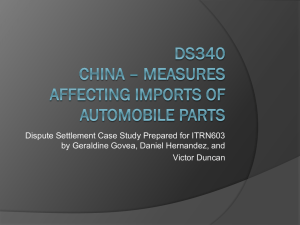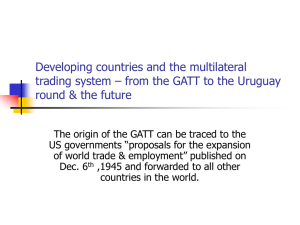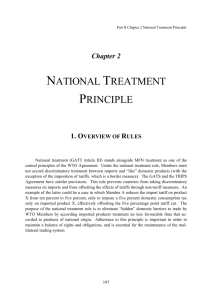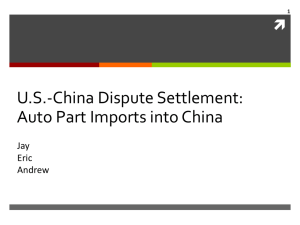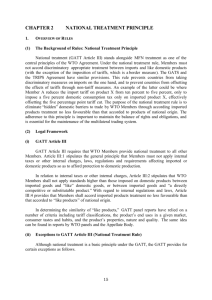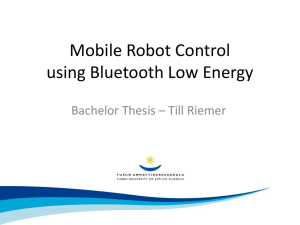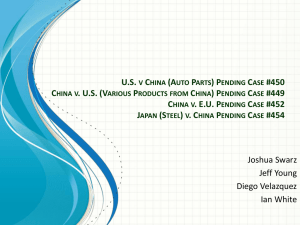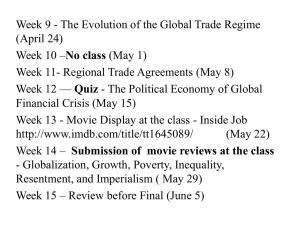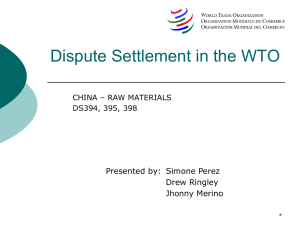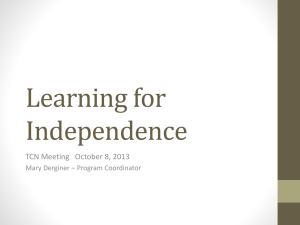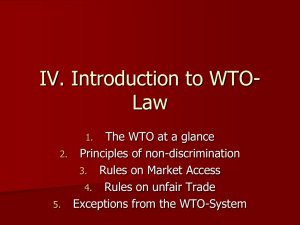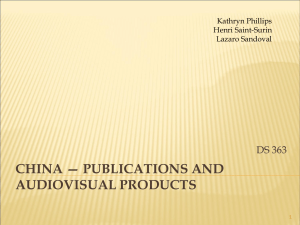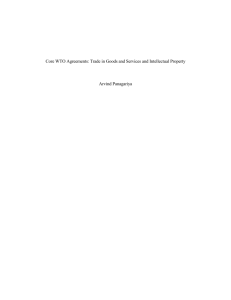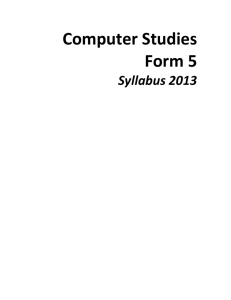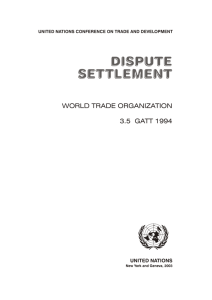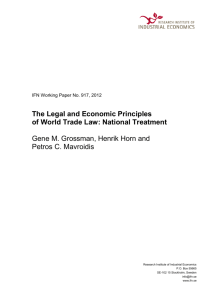Part 1.7.3 of the Accession Protocol
advertisement
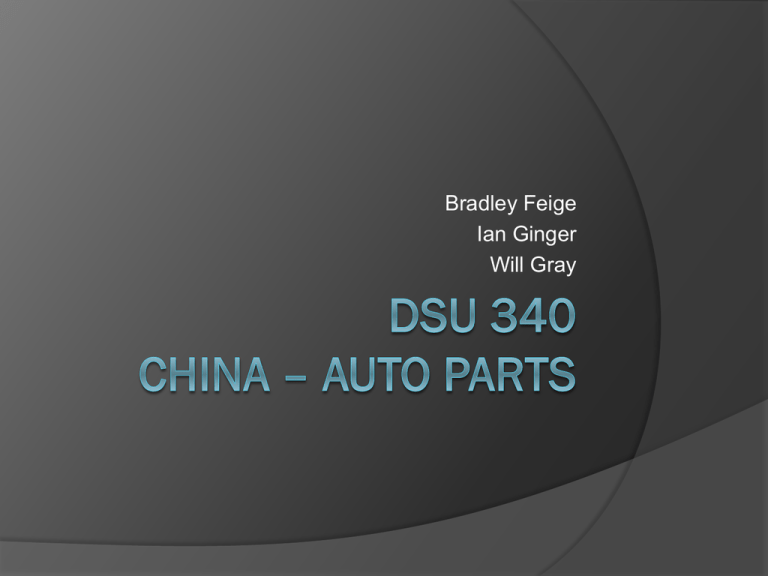
Bradley Feige Ian Ginger Will Gray Outline Background Chronology Main Issues Panel Decision Implementation Trade Policy Issues Conclusion Historical Context With accession to WTO in 2001 China agreed to lower trade barriers for imported autos and auto parts After accession China raised barriers to trade China wanted to develop and protect their auto industry Specifically tap into the auto parts industry Growing middle class market $19 Billion vehicle market (in 2006) Expansion of 9.5% over the past five years Background Information Approximately 88% of imports came from USA, and EU In 2005: EU shipped $2 billion in vehicle parts US shipped $681 million in 2005 Canada shipped $50 million US exports to China in 2005: 64% Parts and access for motor vehicles 18.9% Vehicles for transportation of people 15.3% Other Vehicles 4.4% Special purpose motor vehicles Historical Context Requires GM, VW, Renault and others to purchase 40% from local suppliers More expensive and lower quality If a car is constructed with more than 60% of imported parts: All used imported parts had to be registered to local customs agents Imposed a 25% tariff on each part 10% on completed cars Tried to prevent foreign firms circumventing higher taxes Violated China’s agreement to reduce tariffs on auto imports as agreed upon in 2001. Implementation of Tariff In 2005 China’s Ministry of Finance and the Ministry of Commerce issued Measures for the Administration of Importation of Automotive Parts and Components for Complete Vehicles. Followed by Rules for Determining Whether Imported Automotive Parts and Components Constitute Complete Vehicle. Knock-Down Kits (CKDs) Semi Knock-Down Kits (SKDs) US, EU, and Canada Discouraged Chinese manufactures from using imported parts Unfairly discriminates against foreign auto part producers Put pressure on foreign auto part producers to relocate to China Job Loss Loss of Revenue Timeline of Filings March 30, 2006 – The EU (DS339) and the US (DS340) simultaneously submit requests for consultation with China April 14, 2006 – Canada (DS342) submits its own request for a consultation with China on substantially the same issue July 18, 2008 – The Panel issues its report largely ruling in favor of Canada, the EU and the US Timeline of Filings December 15, 2008 – The Appellate Body issues its own report mostly upholding the Panel’s rulings February 27, 2009 – China reports that it will implement the ruling, and parties agree to give China until September 1, 2009 to do so August 15 and 28, 2009 – Chinese ministries issue various laws and regulations changing the relevant rules to agree with WTO agreements Claimed Violating Chinese Laws Policy 8 Policy on the Development of the Automotive Industry (May 2004) Establishes the legal basis for Decree 125 and Announcement 4, requires various ministries to formulate rules regarding import of automobiles and auto parts. Decree 125 on the Administrative Rules for Importation of Automotive Parts and Components for Complete Vehicles (April 2005) a joint ministerial decree that, among other things, sets the criteria upon which imported auto parts should be considered a complete vehicle. Announcement 4 on the Rules for Determining whether Imported Automotive Parts Constitute the Complete Vehicles (April 2005) provides further detail on the rules set out in Decree 125 and further implements Policy 8. Claimed Violated WTO Articles Per Country Art. II:1 Art. Art. Art. Art. Art. X:1 Art. Art. XXIII: Art. 2.1 & Art. 2.2 Art. 3.1 (b) (a) and III:1 of III:2 of III:4 of III:5 of and X:3 XI:1 of 1(b) of para. 1(a) & of and 3.2 of (b) of GATT GATT GATT GATT (a) of GATT GATT 2(a) of Annex TRIMS the SCM GATT GATT 1 of TRIMS Agreement United States (DS340) x Canada (DS342) x European Union (DS339) x x x x x x x x x x x x x x x x x x x x Part. 1.7.2 of the Accession Protocol Part. 1.7.3 Para. 203 Para. 93 of of of Accession Working Working Protocol Party Party Report Report x x x x x x x x x x x x x x x Principle WTO Articles Under Scrutiny Article II of GATT – requires member laws to treat other members’ commerce no less favorable than what is agreed upon in the original member’s schedule of concessions Article III of GATT – applies National Treatment principle to internal tax laws as well. Principle WTO Articles Under Scrutiny Part 1.7.2 of the Accession Protocol – “…China shall eliminate and shall not introduce, re-introduce or apply non-tariff measures that cannot be justified under the provisions of the WTO Agreement…” Part 1.7.3 of the Accession Protocol – “… China shall ensure that the distribution of import licenses, quotas, tariff-rate quotas, or any other means of approval for importation, the right of importation or investment by national and sub-national authorities, is not conditioned on: whether competing domestic suppliers of such products exist; or performance requirements of any kind, such as local content, offsets, the transfer of technology, export performance or the conduct of research and development in China.” Principle WTO Articles Under Scrutiny Paragraph 93 of Working Party Report – “In response to questions about the tariff treatment for kits for motor vehicles, the representative of China confirmed that China had no tariff lines for completely knocked-down kits for motor vehicles or semi-knocked down kits for motor vehicles. If China created such tariff lines, the tariff rates would be no more than 10 per cent.” Paragraph 203 of Working Party Report – “The representative of China confirmed that upon accession, … China would … eliminate foreign-exchange balancing and trade balancing requirements, local content requirements and export performance requirements… Permission to invest, import licences, quotas and tariff rate quotas would be granted without regard to the existence of competing Chinese domestic suppliers…” Decision July 18, 2008 Policy Order No. 8, Decree 125, and Announcement 4 are inconsistent with Article III:2 of GATT as they impose an internal charge in excess of that on like domestic products They are also inconsistent with Article III: 4 as they give less favorable treatment to imported parts than similar domestic parts They are not justified according Article XX(d) as measures that are necessary to secure compliance with laws or regulations inconsistent with GATT Decision With respect to CKDs (Knock-Down Kit) and SKDs (Semi Knock-Down Kits): (i) Policy Order 8, Decree 125 and Announcement 4 are not inconsistent with Article II:1(b) of the GATT 1994; and (ii) Policy Order 8, Decree 125 and Announcement 4 are inconsistent with China's commitment under paragraph 93 of China's Working Party Report Decision With respect to the United States' claims that Policy Order 8, Decree 125 and Announcement 4 are inconsistent with Article III:5 of the GATT 1994, TRIMs Agreement and SCM Agreement, the Panel decided to exercise judicial economy. With its findings the Panel recommended that the DSB request that China bring all inconsistencies into conformity with its obligations under GATT 1994 and the WTO Decision On 15 September 2008 China notified its decision to appeal to the Appellate Body certain issues of law covered in the Panel reports and certain legal interpretations developed by the Panel. December 15, 2008 The Appellate Body upholds the Panel’s decision Implementation February 11, 2009 China informs the DSB that it would implement its recommendations but would need reasonable time to do so Reasonable time is agreed upon as being 7 months and 20 days August 28, 2009 China informs DSB that the General Administration on Customs and relevant agencies had promulgated a joint decree repealing Decree 125 August 31, 2009 China informs DSB that the Ministry of Industry and Information Technology, and National Development and Reform Commission, had issued a joint decree to stop the implementation of relevant provisions concerning the importation of auto parts in the Automobile Industry Development Policy. Trade Policy Issues Access of the U.S. automobile industry to the Chinese market China’s attempt to create “export bases” from which its seeks to increase its exportation of a variety of goods Effect of auto industry barriers Employment in the US auto sector industry dropped 10.2 % in 2008 and an additional 23% in 2009. China’s auto part exports to the US have increased 43% from 2004 to 2009 Further Implications DS 440 regarding dumping and subsidies on US auto imports filed against China in 2012 DS 450 regarding subsidies on autos and auto parts filed against China in 2012 Questions?

